The Old Moon Meets Mars and Mercury in Morning, Maybe Many Meteors, Venus Kisses Jupiter, and Seeing the Seven Sisters!
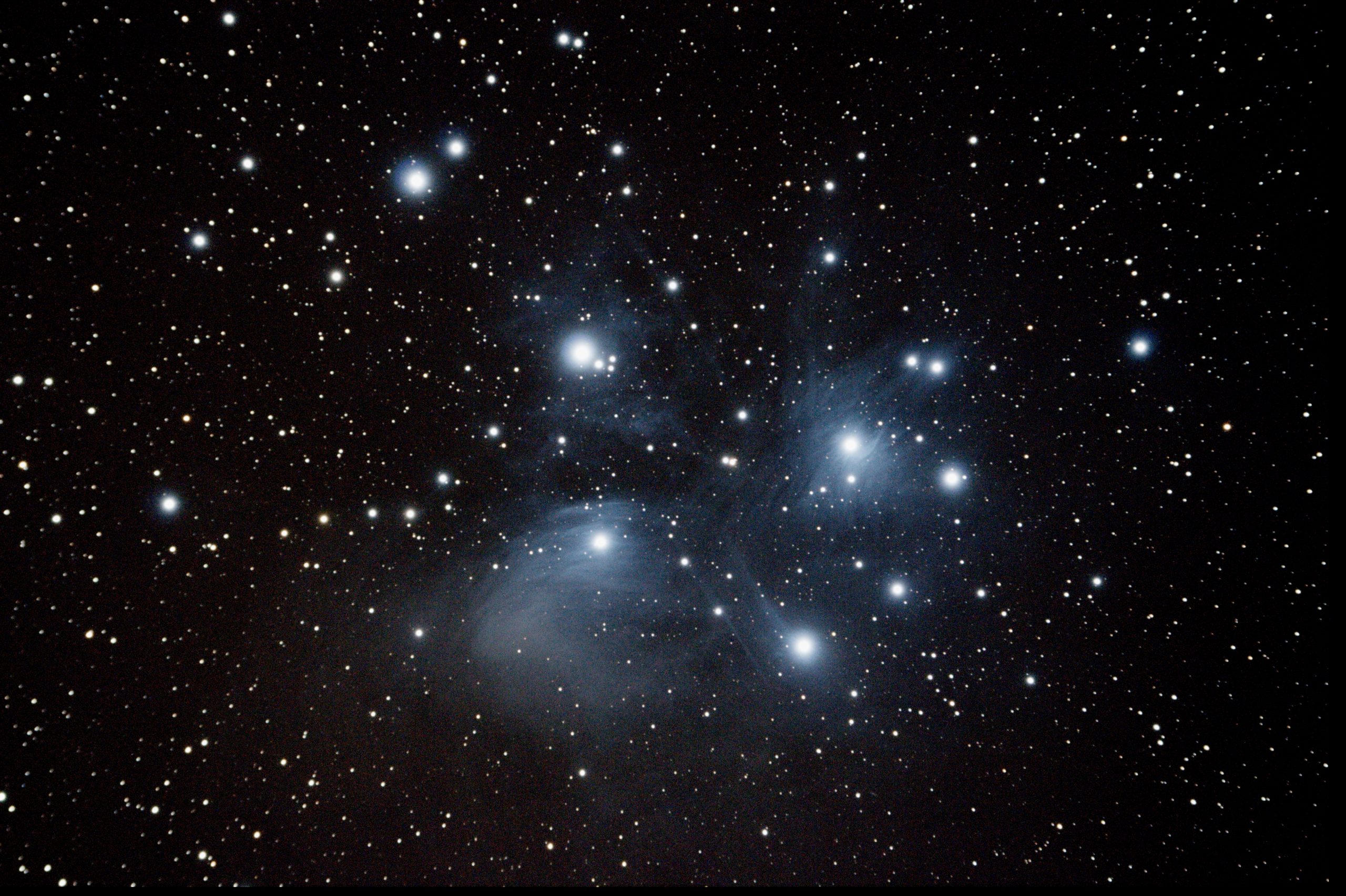
This image of the beautiful Pleiades open star cluster, also known as the Seven sisters, Subaru, and Messier 45 was captured by Stuart Norman of Toronto from a dark sky location near Georgian Bay, Ontario on October 19, 2017. The blue nebulosity is light from the sibling stars being reflected off interstellar gas and dust.
Hello, November Stargazers!
Here are your Astronomy Skylights for the week of November 17th, 2019 by Chris Vaughan. Feel free to pass this along to your friends and send me your comments, questions, and suggested topics. I repost these emails with photos at http://astrogeo.ca/skylights/ where all the old editions will be archived. You can also follow me on Twitter as @astrogeoguy! Unless otherwise noted, all times are Eastern Time. To subscribe to these emails please click this MailChimp link.
I can bring my Digital Starlab portable inflatable planetarium to your school or other daytime or evening event. Contact me through AstroGeo.ca, and we’ll tour the Universe together!
Darker skies this week will permit viewing deep sky objects like the Seven Sisters in Taurus, and the Andromeda Galaxy, which I wrote about finding here. In addition to the Leonids, a second, usually modest, meteor shower might deliver a bigger show this week. The worldwide evening sky this week will deliver a spectacular meet-up of the two brightest planets, Venus and Jupiter – with Saturn not too far from them. And the moon, Mercury, and Mars will meet before the morning sun. Here are your Skylights!
Meteor Showers This Week
The annual Leonids Meteor shower, derived from material left by repeated passages of periodic Comet 55P/Tempel-Tuttle, runs from November 5th to December 3rd. It peaked before dawn this morning (Sunday, November 17), but you can expect to see some leftover Leonids, many with persistent trains, over the following few evenings. The bright, waning gibbous moon on the peak night will brighten the sky, washing out many of these meteors, too.

This shower is a worldwide event. You can start watching for meteors as soon as it’s dark. The best viewing time will occur on the peak night in the hours after midnight local time, when the shower’s radiant will be highest in the sky. (When a shower’s radiant is low in the sky, the local horizon hides many of the meteors.) I wouldn’t make a special trip to see meteors with so much moonlight – but keep an eye out for them if you are already outside on a clear night.
Astronomers reported recently that a very minor annual shower called the Alpha Monocerotids may deliver an unusual burst of meteors on the night of Thursday-into-Friday this week. The burst is predicted to be very brief – lasting only about an hour centred on 11:50 pm EST. The radiant for this shower is actually near the bright star Procyon in Canis Minor (the Little Dog). For observers in Europe and Africa, the source of the meors will be nice and high in the eastern sky at the peak time. For the Great Lakes Region, the radiant will be low in the eastern sky – so the lower half of the meteors will be hidden by the Earth. Thankfully, the moon will be a slim waning crescent that doesn’t rise until well after midnight. Good luck to us all!
The Moon and Planets
The moon will spend this week in the latter stages of its monthly trip around the Earth. For observers the world over, our natural satellite will start the week as a slightly more than half-illuminated orb, and end the week as a slim waning crescent in the pre-dawn east.
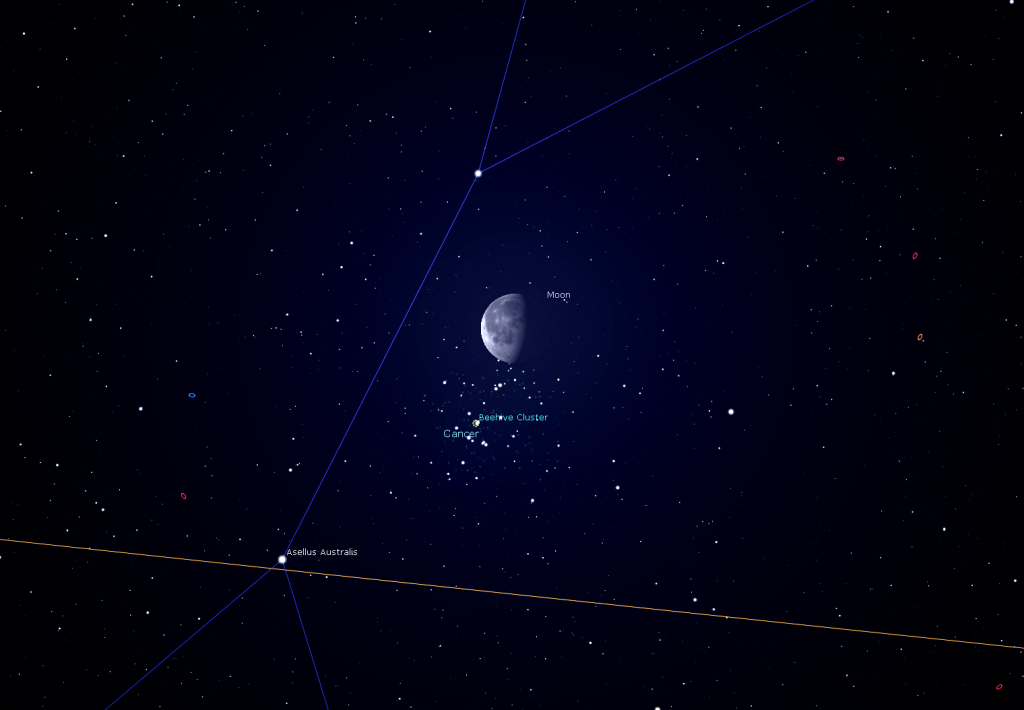
When the moon rises tonight (Sunday) at around 9:30 pm local time, it will be sitting about 3 finger widths above (or to the celestial west of) the large, open star cluster known as the Beehive (and Messier 44) in Cancer (the Crab). During the night, the moon’s orbital motion will cause it to approach and then pass just above the heart of that cluster before dawn on Monday. (Tuck the moon just out of sight above the field of view of your binoculars and look for the cluster’s many stars.)
From Tuesday through Thursday, the waning moon will rise in the middle of the night and traverse the stars of Leo (the Lion). The moon will pass a few finger widths to the left of Leo’s bright, white star Regulus on Tuesday. On the coming weekend, observers will see the moon in the eastern pre-dawn sky among the stars of Virgo (the Maiden).
On Sunday morning before dawn, look for the gorgeous slim crescent moon sitting only a few finger widths to the left (or celestial north) of dim, red-tinted Mars, while brighter Mercury will appear 9° (a slim fist’s diameter) below the moon and Mars. Mercury, Even without the moon on Sunday, Mars, and the bright, white star Spica will make a nice upright line in the sky from about 6 am local time to morning twilight later this week.

Speaking of Mercury, the swift innermost planet will appear very low in the east-southeastern pre-dawn sky all week – becoming higher and easier to spot every morning. The best viewing time will be before 6:30 am local time. This morning apparition for Mercury will be a very good one for Northern Hemisphere observers, but a poor one for those viewing it from mid-southern latitudes.
Rising at about 5 am local time this week, reddish Mars is becoming nicely visible in the eastern pre-dawn sky while it continues to climb away from the pre-dawn sun. From now until October, 2020, Mars will continuously grow in brightness in the sky – and in apparent size when viewed in telescopes. In fact, the 2020 Mars opposition will be a terrific excuse to get a telescope for the 2019 Holidays so you can practice viewing the planet during the spring and summer months of 2020!
Now shining at a spectacularly bright magnitude of -3.85, Venus is still being held low in the southwestern post-sunset sky by the shallow angle of the evening ecliptic. The planet is gradually ascending out of the surrounding evening twilight, and will be fairly easy to spot for a while after sunset this week, if you can find an open horizon to the southwest. The planet will set at 6:10 pm local time.
Jupiter and Venus are moving in opposite directions – which will cause them to meet up spectacularly this coming weekend! Venus’ orbital motion is carrying it eastward away from the sun, while Jupiter (along with the stars around it) is being carried westward toward the sun by the Earth’s orbital motion.
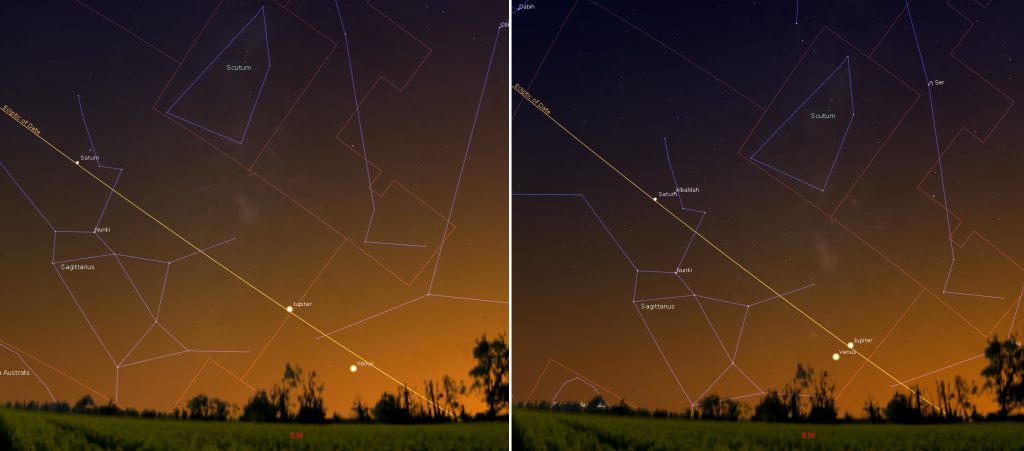
Tonight (Sunday) Jupiter will be setting in the west at about 6:45 pm local time. As the sky begins to darken, look for the giant planet sitting less than a fist’s diameter above the southwestern horizon, with Venus sitting a palm’s width to its lower right. Venus will appear about six times brighter than Jupiter. By next Saturday and Sunday night, Jupiter will be sitting less than 2 finger widths to the upper right (or to the celestial north) of Venus. Next week, their separation will increase as Jupiter sinks sunward.
Yellow-tinted Saturn, which is about ten times less bright than Jupiter, is still a reasonably good option for viewing in backyard telescopes. Saturn is positioned about 2 fist diameters to the upper left (or celestial east) of Jupiter. Start looking for the ringed planet in the lower part of the south-southwestern evening sky after dusk, when Saturn will be located about two fist diameters above the horizon. It will set in the west-southwest at 8:15 pm local time.
Saturn is well worth dusting off your old telescope for a look! Once the sky is dark, even a small telescope will show Saturn’s rings and several of its brighter moons, especially Titan! Because Saturn’s axis of rotation is tipped about 27° from vertical (a bit more than Earth’s axis), we can see the top surface of its rings, and its moons can arrange themselves above, below, or to either side of the planet. During this week, Titan will migrate counter-clockwise around Saturn, moving from the right of Saturn tonight (Sunday) to the left of the planet next Sunday. (Remember that your telescope will flip the view around.)
Next in line along the night-time ecliptic’s array of planets, distant and dim, blue Neptune is visible from full evening darkness until shortly after midnight local time. It is sitting among the stars of eastern Aquarius (the Water-Bearer), and sits less than a finger’s width to the right (or celestial west) of a medium-bright star named Phi (φ) Aquarii. Both blue Neptune and that golden-coloured star will appear together in the field of view of a backyard telescope at low power. The distance between the star and the planet is steadily increasing due to Neptune’s westward retrograde orbital motion. I posted a diagram of Neptune’s position compared to that star here. With the bright moon out of the night sky, magnitude 7.9 Neptune is actually visible in binoculars. Find Phi Aquarii in binoculars and then locate nearby Neptune.
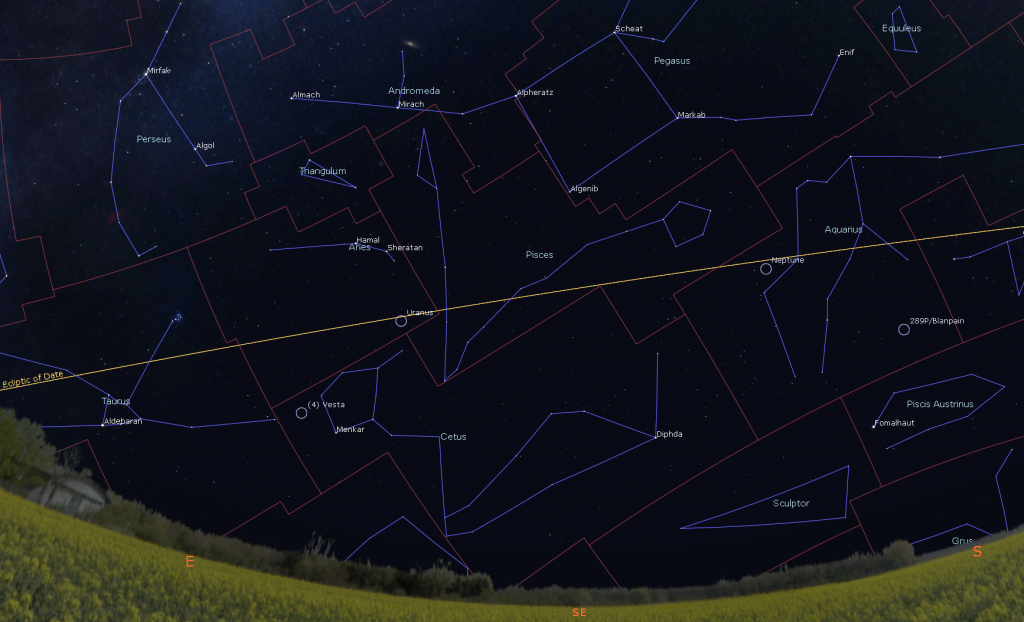
Blue-green Uranus is only a few weeks past its minimum distance from Earth for this year, so it is still near peak visibility for 2019. This fall, Uranus is sitting a large palm’s width to the left (or to the celestial east) of the “V” of Pisces (the Fishes), below (or to the celestial south of) the stars of Aries (the Ram), and is just a palm’s width above the ring of stars that form the head of Cetus (the Whale).
Shining at a peak brightness of magnitude 5.7, Uranus is also bright enough to see in binoculars and small telescopes under dark skies. You can use the three modest stars that form the top of the head of the whale (or sea-monster in some tales) to locate Uranus for the next several months – because the distant planet moves so slowly in its orbit. To help you find it, I posted a detailed star chart here. If you can wait until about 10:30 pm local time to view it, when it is higher in the sky, you’ll be looking through the least amount of Earth’s disturbing atmosphere.
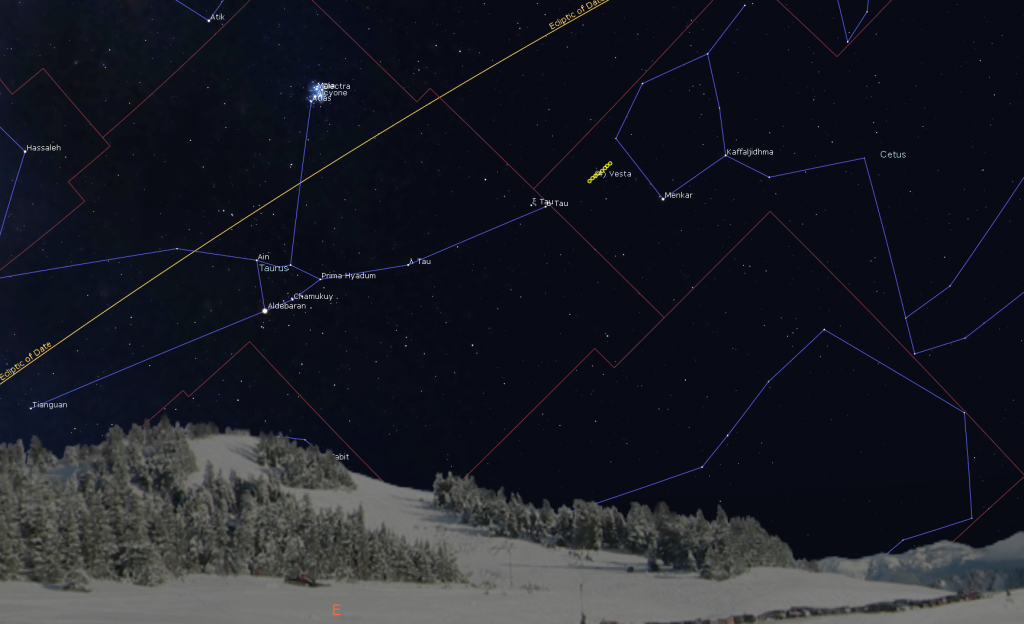
Last Tuesday, Earth’s orbit carried us between the minor planet (and asteroid) Vesta and the sun – allowing Vesta to be visible all night long, and to appear at its brightest (magnitude 6.5) for the year – well within reach of binoculars and small telescopes. Look for Vesta in eastern Cetus (the Whale). The asteroid is a palm’s width to the left of the star Menkar in the direction of the Pleiades star cluster (more on that object below).
Seeing the Seven Sisters
As the sky darkens this week, the distinctive winter constellation of Taurus (the Bull) is rising in the east. The constellation is dominated by the very bright, orange star Aldebaran, which marks the bull’s southern eye – and a V-shaped group of stars, known as the Hyades cluster, that form the rest of the bull’s triangular face. When he rises, the bull is tipped sideways, and then becomes upright at about 1 am local time.
One of my favorite objects in Taurus sits about one and a half fist widths above (or to the celestial north of) the bull’s face. It is the beautiful open star cluster known as The Pleiades, or the Seven Sisters. It’s also designated Messier 45 (or M45), part of Charles Messier’s famous list of comet-like objects. The Pleiades is made up of the young, hot blue stars named Asterope (“A-STER-oh-pee”), Merope, Electra, Maia, Taygeta, Celaeno, and Alcyone. They are indeed related – born of the same primordial gas cloud. In Greek mythology, they were the daughters of Atlas, and half sisters of the Hyades. To the unaided eye, only six of the sisters are usually seen, with their parent stars Atlas and Pleione huddled together at the east end of the grouping. Under magnification, hundreds of stars appear.
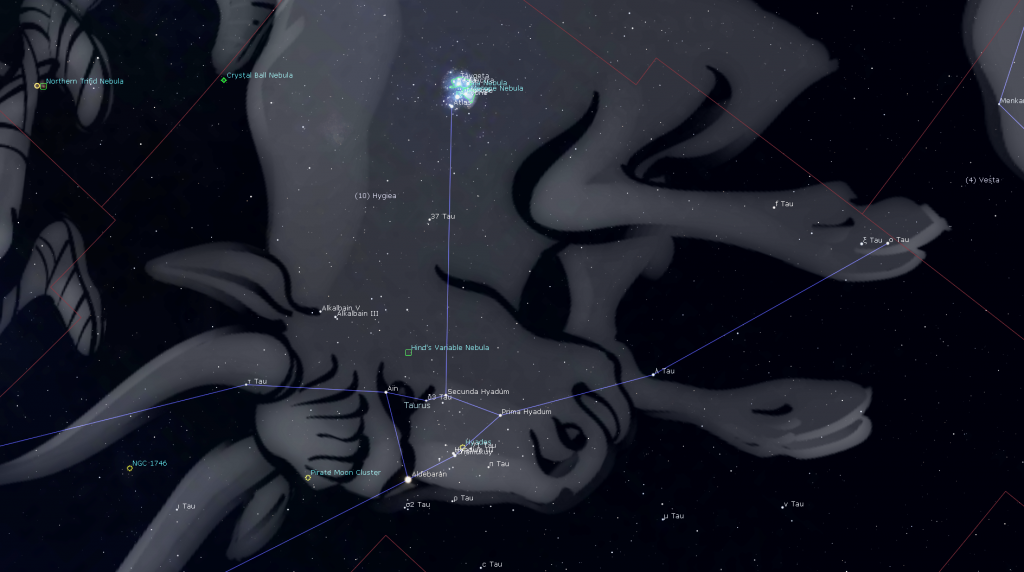
The Pleiades cluster is about 450 light years away from our sun, and makes a wonderful target in binoculars or a telescope at low magnification, where many more siblings are revealed! A large telescope under dark skies will also reveal blue nebulosity around the stars – this is reflected light from unrelated gas and dust that the stars are passing through.
Galileo was among the first to observe the cluster in a telescope. In 1610, he published a sketch made at the eyepiece. Not surprisingly, many cultures, including Aztec, Maori, Sioux, Hindu, and more, have noted this object and developed stories around it. In Japan, it is called Suburu, and forms the logo of the eponymous car maker. Due to its shape and diminutive size, some people mistake the Pleiades for the Little Dipper. While the shapes are similar, the Little Dipper is twenty times larger than the Seven Sisters!
Public Astro-Themed Events
Every Monday evening, York University’s Allan I. Carswell Observatory runs an online star party – broadcasting views from four telescopes/cameras, answering viewer questions, and taking requests! Details are here. On Wednesday nights they offer free public viewing through their rooftop telescopes, including their brand new 1-metre telescope! If it’s cloudy, the astronomers give tours and presentations. Registration and details are here.
On Friday, November 22 from 7 to 9 pm, join staff at the Kortright Centre for Conservation for Astronomy Night – A Night with the Stars featuring a talk and sky tour. Tickets and details are here.
On Friday, November 22 from 8 to 11 pm, adults can enjoy some suds with their science at Astronomy on Tap T.O. at the Great Hall on Queen Street West, a free event hosted by the U of T’s Dunlap Institute. Talks, trivia, contest giveaways, and more! Details are here.
On Saturday, November 23 at 2:30 pm in the Toronto Brentwood Library, local astronomer Tom Vassos will present a free public talk entitled A Fascinating Tour of the Universe. Registration details are here.
On Sunday afternoon, November 24, from 2 to 4 pm at the Medical Science Building at U of T, the Royal Canadian Institute for Science and the Royal Astronomical Society of Canada will jointly present Black Holes: From Speculative to Spectacular, featuring a panel of experts moderated by science outreach specialist Dr. Jesse Rogerson. Details and registration are here.
This Fall and Winter, spend a Sunday afternoon in the other dome at the David Dunlap Observatory! On Sunday afternoon, December 8, from noon to 4 pm, join me in my Starlab Digital Planetarium for an interactive journey through the Universe at DDO. We’ll tour the night sky and see close-up views of galaxies, nebulas, and star clusters, view our Solar System’s planets and alien exo-planets, land on the moon, Mars – and the Sun, travel home to Earth from the edge of the Universe, hear indigenous starlore, and watch immersive fulldome movies! Ask me your burning questions, and see the answers in a planetarium setting – or sit back and soak it all in. Sessions run continuously between noon and 4 pm. Ticket-holders may arrive any time during the program. The program is suitable for ages 3 and older, and the Starlab planetarium is wheelchair accessible. For tickets, please use this link.
Keep looking up, and enjoy the sky when you do. I love questions and requests – so, send me some!